AFFF Exposure Symptoms for Navy Service Members
- Last Updated: July 14th, 2025

Attorney Jessica Paluch-Hoerman, founder of TruLaw, has over 28 years of experience as a personal injury and mass tort attorney, and previously worked as an international tax attorney at Deloitte. Jessie collaborates with attorneys nationwide — enabling her to share reliable, up-to-date legal information with our readers.
Legally Reviewed
This article has been written and reviewed for legal accuracy and clarity by the team of writers and legal experts at TruLaw and is as accurate as possible. This content should not be taken as legal advice from an attorney. If you would like to learn more about our owner and experienced injury lawyer, Jessie Paluch, you can do so here.
Fact-Checked
TruLaw does everything possible to make sure the information in this article is up to date and accurate. If you need specific legal advice about your case, contact us by using the chat on the bottom of this page. This article should not be taken as advice from an attorney.
Key takeaways:
- AFFF exposure can cause various health issues, including respiratory problems, skin irritation, and an increased risk of certain cancers.
- Navy veterans exposed to AFFF may be eligible for VA disability benefits and can join lawsuits against manufacturers to seek compensation for medical expenses and lost wages.
- The military is working to prevent future AFFF exposure by implementing safer alternatives, enhancing safety protocols, and training of the risks associated with these chemicals.
Overview of AFFF Exposure Symptoms
On this page, we’ll discuss AFFF Exposure Symptoms, potential health effects of exposure to firefighting foam, what to do if you experience symptoms related to AFFF exposure, and much more.
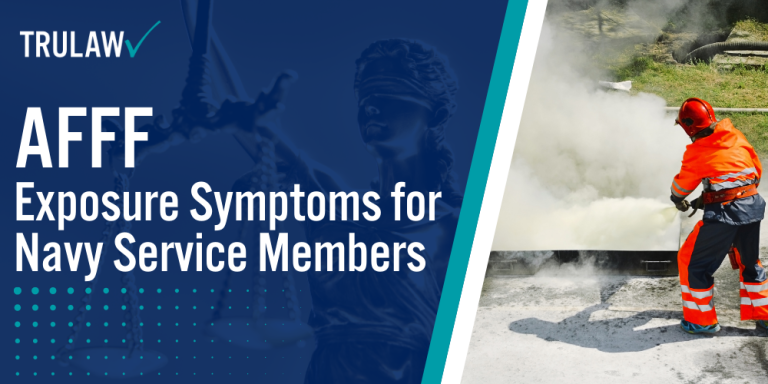
Intro to AFFF Exposure Symptoms
Exposure to AFFF firefighting foam has been linked to various health issues, including but not limited to:
- Carcinogens: Studies suggest that AFFF exposure may increase the risk of certain cancers, such as testicular, kidney, and pancreatic cancer.
- Thyroid Problems: PFAS chemicals in AFFF have been associated with thyroid dysfunction and related disorders.
- Reproductive Issues: AFFF exposure may impact fertility and lead to pregnancy complications.
- Immune System Dysfunction: PFAS in AFFF can weaken the immune system, making individuals more susceptible to illnesses.
If you have experienced health problems that you believe may be related to AFFF exposure, it’s crucial to seek medical attention and consult with an experienced attorney about your legal options.
Contact TruLaw using the chat feature on this page for a free case evaluation to learn more about your rights and potential compensation.
Table of Contents
Understanding AFFF Exposure Symptoms
Exposure to Aqueous Film Forming Foam (AFFF) can lead to serious health concerns for individuals, particularly military personnel who have used the foam in circumstances that require extinguishing flammable liquid fires.
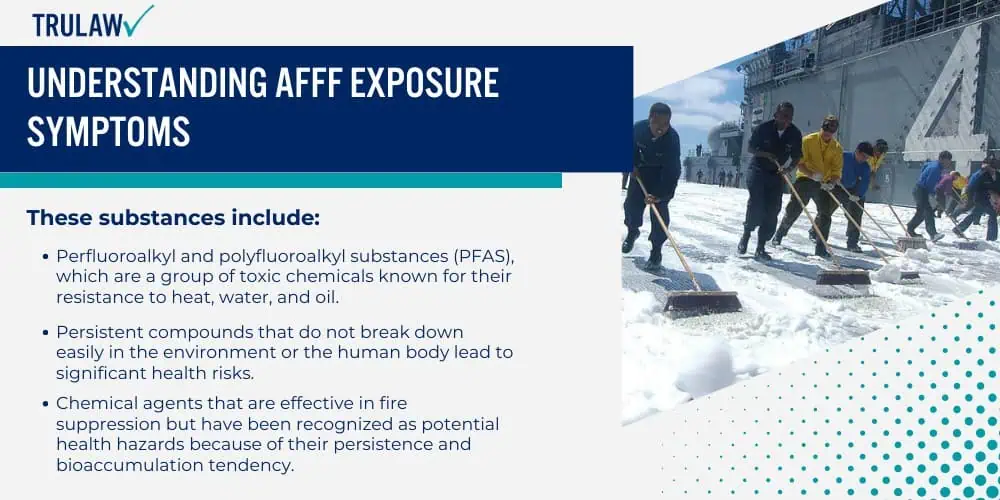
Recognizing symptoms of AFFF exposure is crucial for managing potential health hazards.
What Are AFFF Chemicals?
AFFF, or Aqueous Film Forming Foam, comprises harmful substances that create a film to extinguish flammable liquid fires quickly.
These substances include:
- Perfluoroalkyl and polyfluoroalkyl substances (PFAS), which are a group of toxic chemicals known for their resistance to heat, water, and oil.
- Persistent compounds that do not break down easily in the environment or the human body lead to significant health risks.
- Chemical agents that are effective in fire suppression but have been recognized as potential health hazards because of their persistence and bioaccumulation tendency.
- Surfactants and solvents that enhance the foam’s spreading and penetrating capabilities during firefighting operations.
How Navy Personnel Were Exposed to AFFF
AFFF, a firefighting foam widely used by the Navy, was employed in various training and operational scenarios, leading to direct exposure among personnel.
Navy staff contacted AFFF during fire drills, equipment testing, and emergencies, increasing their risk of harmful chemical exposure.
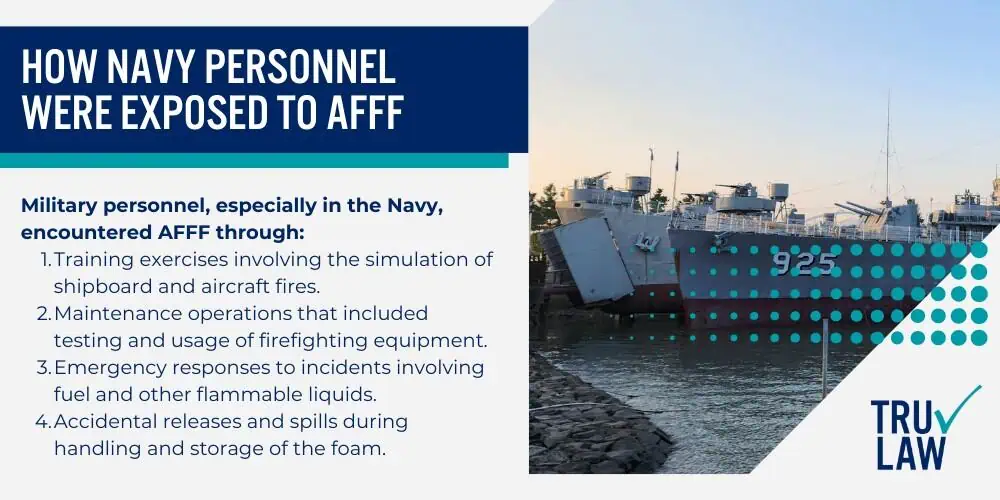
Military personnel, especially in the Navy, encountered AFFF through:
- Training exercises involving the simulation of shipboard and aircraft fires.
- Maintenance operations that included testing and usage of firefighting equipment.
- Emergency responses to incidents involving fuel and other flammable liquids.
- Accidental releases and spills during handling and storage of the foam.
Importance of Recognizing AFFF Exposure Symptoms
Veterans and workers may suffer from serious health issues due to exposure to AFFF.
Early recognition of symptoms can lead to better outcomes and highlight health hazards like:
- Changes in liver enzyme levels and lipid profiles.
- Increased risk of developing cancer, such as kidney and testicular cancer.
- Hormonal disruptions and potential immune system effects.
- Manifestations in children, such as developmental delays due to prenatal exposures.
Common AFFF Exposure Symptoms
Exposure to Aqueous Film Forming Foam (AFFF) presents several health risks as it contains toxic substances known to affect the human body.
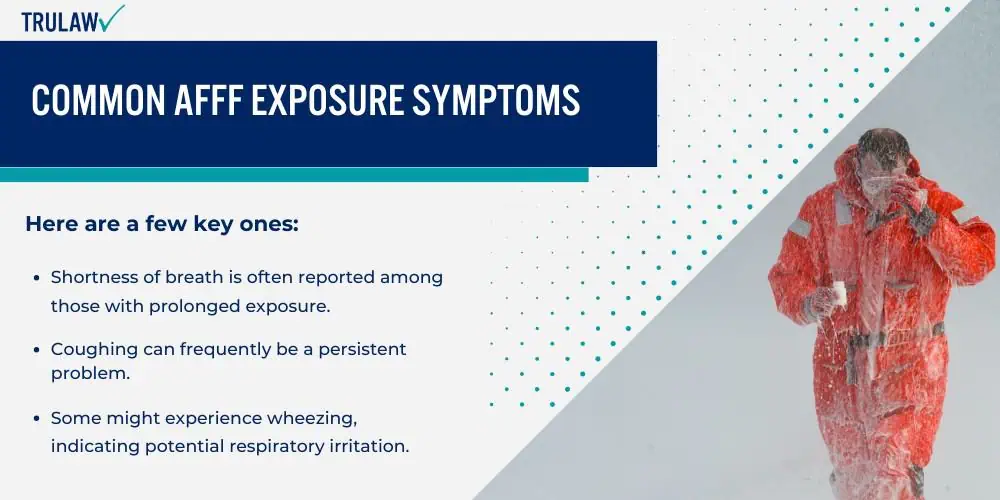
This section details specific negative health outcomes related to AFFF exposure symptoms.
Respiratory Issues Linked to AFFF Exposure
Individuals exposed to AFFF may experience a range of respiratory symptoms.
Here are a few key ones:
- Shortness of breath is often reported among those with prolonged exposure.
- Coughing can frequently be a persistent problem.
- Some might experience wheezing, indicating potential respiratory irritation.
- In severe cases, chemical pneumonitis, an inflammation of the lungs, might develop after direct inhalation.
Digestive Problems Associated with AFFF Chemicals
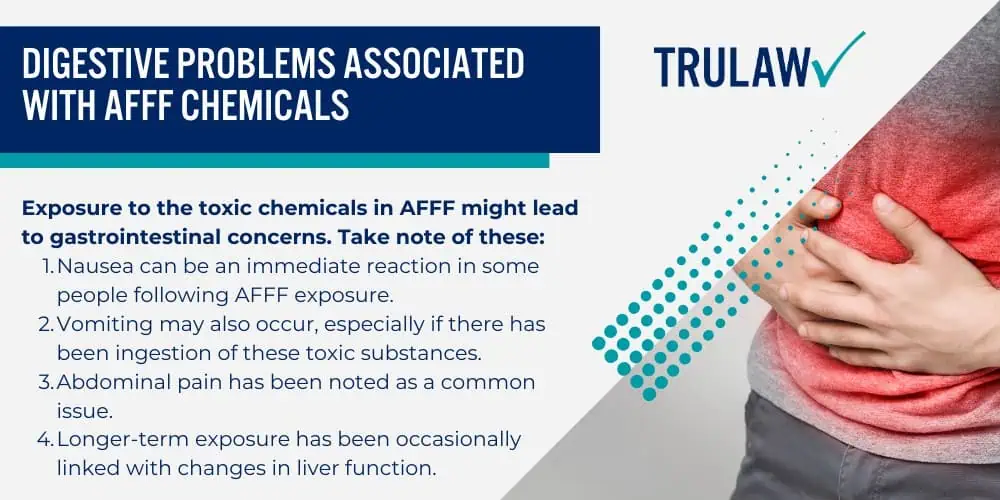
Exposure to the toxic chemicals in AFFF might lead to gastrointestinal concerns.
Take note of these:
- Nausea can be an immediate reaction in some people following AFFF exposure.
- Vomiting may also occur, especially if there has been ingestion of these toxic substances.
- Abdominal pain has been noted as a common issue.
- Longer-term exposure has been occasionally linked with changes in liver function.
Skin Irritation and Rashes from AFFF Contact
Skin contact with AFFF may manifest through several dermatological symptoms.
Examples include, but are not limited to:
- Skin irritation that ranges from mild to severe can occur upon contact.
- Redness and swelling may be evident at the site of exposure.
- Some individuals develop rashes that can be symptomatic of an allergic reaction.
- Continuous exposure may cause more persistent skin conditions like dermatitis.
Long-Term Health Effects of AFFF Exposure
Aqueous Film-Forming Foams (AFFF) have been utilized in firefighting to enhance their effectiveness in extinguishing fuel fires.
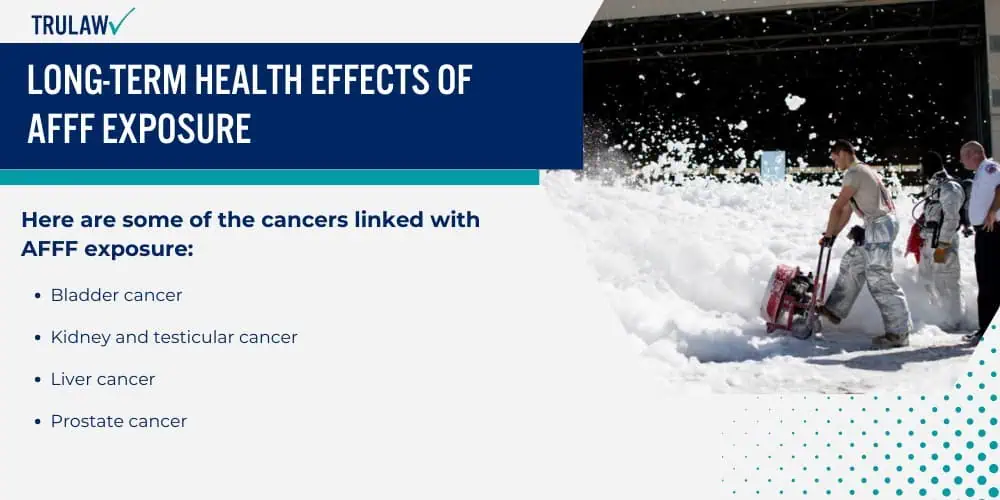
However, exposure to these substances has been increasingly associated with serious long-term health consequences.
Increased Risk of Certain Cancers
Studies suggest a heightened risk for military firefighters and others with prolonged AFFF exposure, particularly regarding certain types of cancers.
Here are some of the cancers linked with AFFF exposure:
- Bladder cancer
- Kidney and testicular cancer
- Liver cancer
- Prostate cancer
These associations are compelling, pointing to the need for awareness and precautionary measures for those exposed to AFFF over time.
Potential Endocrine Disruption and Hormonal Imbalances
Exposure to AFFF, which contains perfluorinated chemicals, has been connected to possible endocrine disruption.
This can lead to various hormonal imbalances with significant health implications.
Key concerns include:
- Alterations in thyroid hormone production
- Changes in steroid hormones
- Disruptions in metabolic homeostasis
- Potential insulin resistance
These factors play extensive roles in an individual’s overall hormonal health and well-being.
Reproductive and Developmental Concerns
When it comes to reproductive health, AFFF exposure has raised alarms.
Notable impacts include:
- Potential fertility issues
- Associations with developmental issues in unborn children
- Interference with normal growth patterns
- A possible increase in the risk of pregnancy complications
Those exposed to AFFF, especially in occupational settings, should be informed of these possible reproductive and developmental concerns.
Diagnosing AFFF Exposure Symptoms
When individuals are exposed to Aqueous Film-Forming Foam (AFFF), determining the presence of related chemicals in the body and linking them to symptoms can be challenging due to the variable manifestations and the subtle nature of the effects.
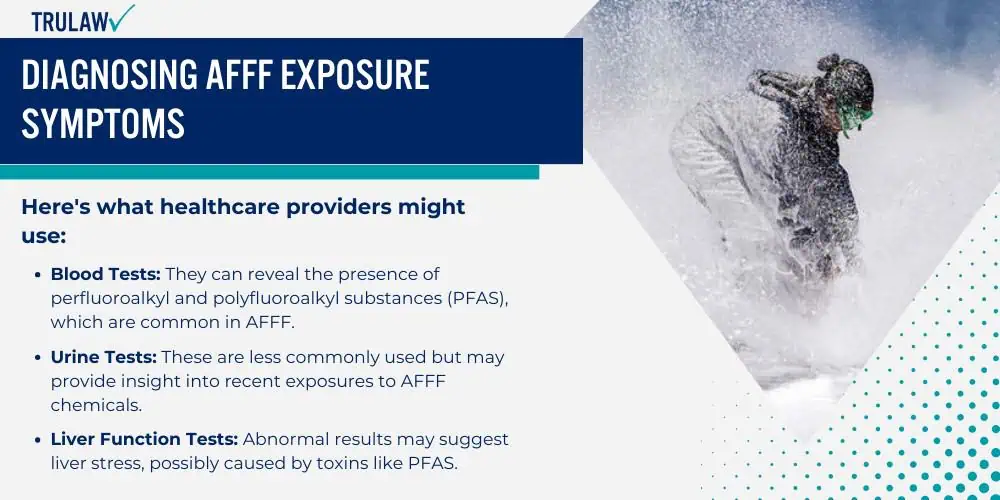
Medical Tests to Detect AFFF Chemicals in the Body
Medical tests are vital for detecting the presence of AFFF chemicals in an individual.
Here’s what healthcare providers might use:
- Blood Tests: They can reveal the presence of perfluoroalkyl and polyfluoroalkyl substances (PFAS), which are common in AFFF.
- Urine Tests: These are less commonly used but may provide insight into recent exposures to AFFF chemicals.
- Liver Function Tests: Abnormal results may suggest liver stress, possibly caused by toxins like PFAS.
- Thyroid Function Tests: Disruption in thyroid hormone levels can sometimes be linked to exposure to certain chemicals in AFFF.
Importance of Disclosing AFFF Exposure to Healthcare Providers
Patients need to inform healthcare providers about potential AFFF exposure.
This can help the healthcare team make more informed decisions:
- Comprehensive Medical History: Integrating information about AFFF exposure can guide further testing and management.
- Assessment of Symptoms: Knowing about AFFF exposure allows for a better interpretation of symptoms that might otherwise be nonspecific.
- Tailoring of Health Screening: Exposure history can lead healthcare providers to conduct more targeted screening for PFAS-related effects.
- Preventive Measures: Early knowledge of exposure might prompt more proactive monitoring and preventive strategies.
Challenges in Linking Symptoms to AFFF Exposure
The ambiguity of symptoms linked to AFFF exposure complicates diagnosis and attribution, as signs can vary widely in severity and type.
Additionally, some symptoms may not become apparent until years after exposure, obscuring the direct connection to AFFF-related chemicals like PFAS.
Several factors make it difficult to connect symptoms to AFFF exposure directly:
- Symptom Variability: AFFF exposure symptoms can range from subtle to more severe health complications, often mimicking other conditions.
- Lack of Specificity: Many of the symptoms associated with PFAS exposure are also common to various other ailments.
- Delayed Presentation: Symptoms may appear long after the initial exposure, making it hard to link them directly to AFFF.
- Insufficient Conclusive Data: While evidence exists, establishing a firm causal link between AFFF exposure and certain health effects remains an ongoing effort.
Treatment Options for AFFF Exposure Symptoms
When exposed to AFFF (aqueous film-forming foam), it’s important to understand the treatment options available to manage symptoms and mitigate human health risks.
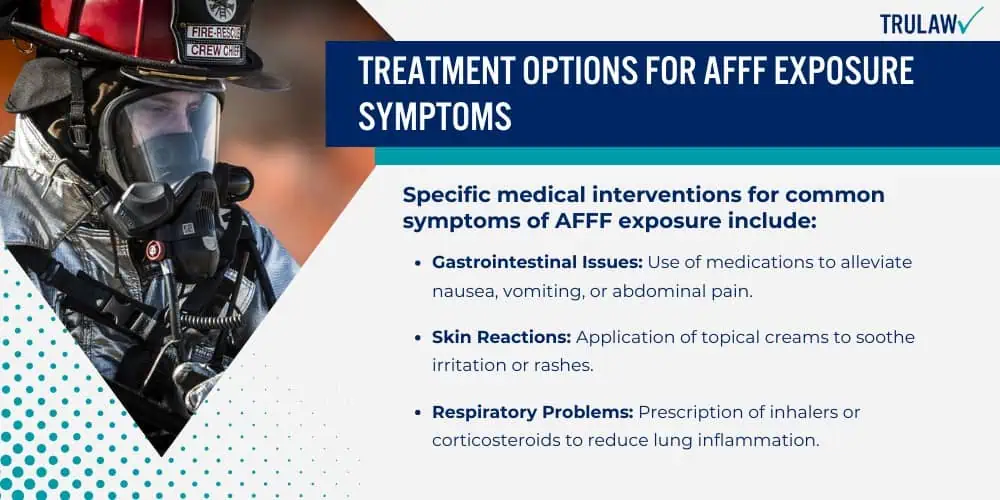
This involves medical interventions, lifestyle adjustments, and continual health monitoring to ensure the best outcomes for affected individuals.
Medical Interventions for Specific Symptoms
Healthcare professionals often address symptoms of AFFF exposure with various medical treatments.
Depending on the symptomatology, treatment options may be tailored to the individual’s needs.
Specific medical interventions for common symptoms of AFFF exposure include:
- Gastrointestinal Issues: Use of medications to alleviate nausea, vomiting, or abdominal pain.
- Skin Reactions: Application of topical creams to soothe irritation or rashes.
- Respiratory Problems: Prescription of inhalers or corticosteroids to reduce lung inflammation.
- Thyroid Function Alterations: Monitoring and potential hormonal therapy for thyroid dysfunction.
- Elevated Cholesterol: Medication to manage high cholesterol levels linked to PFAS exposure.
Lifestyle Changes to Mitigate Health Risks
Proactive adjustments in daily life can help individuals reduce the potential human health risks associated with AFFF exposure.
Adopting these lifestyle changes can contribute to improved health and reduced exposure risks:
- Dietary Alterations: Increasing intake of clean, unprocessed foods to support overall health.
- Exercise Regularity: Engaging in regular physical activity to enhance metabolic function.
- Water Consumption: Ensure drinking water is clean to avoid further exposure.
- Product Choices: Avoiding products containing PFAS to minimize additional exposure.
Ongoing Monitoring and Follow-Up Care
Consistent monitoring of health markers and symptoms is essential for those exposed to AFFF.
A comprehensive approach to ongoing monitoring and follow-up care includes the following practices:
- Regular Health Checkups: Scheduling routine appointments with healthcare providers for continual oversight.
- Blood Tests: Periodic testing to monitor PFAS levels and check for health indicators influenced by PFAS.
- Health Surveillance: Community-level health monitoring for groups at high risk of AFFF exposure.
- Awareness: Educating the individual about signs and symptoms to watch for that may warrant immediate medical attention.
Legal Recourse for Navy Personnel with AFFF Exposure Symptoms
Navigating the legal landscape after exposure to Aqueous Film Forming Foam (AFFF) can be daunting.
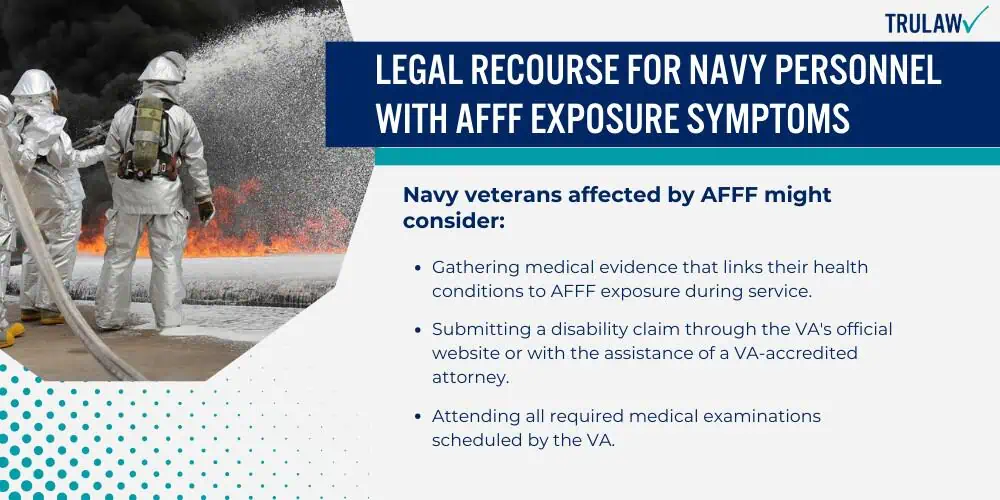
Navy personnel who develop health issues related to AFFF exposure may have several legal options to pursue compensation and benefits for their conditions.
Filing VA Disability Claims for AFFF-Related Health Issues
Veterans Affairs (VA) disability claims offer a path to benefits for service-related health problems.
Navy veterans affected by AFFF might consider:
- Gathering medical evidence that links their health conditions to AFFF exposure during service.
- Submitting a disability claim through the VA’s official website or with the assistance of a VA-accredited attorney.
- Attending all required medical examinations scheduled by the VA.
- Following up on the claim status and seeking legal assistance.
Joining AFFF Exposure Lawsuits Against Manufacturers
In some instances, AFFF lawsuits target the manufacturers due to the negative health effects of their products.
Those affected may:
- Research ongoing AFFF firefighting foam MDL to determine if they can participate.
- Contact a law firm specializing in toxic exposure cases for a thorough evaluation.
- Provide all necessary employment and medical documents to their firefighting foam cancer lawyers.
- Join a class-action suit or file a personal injury claim if applicable.
Seeking Compensation for Medical Expenses and Lost Wages
Personal injury claims may serve as a conduit for financial recovery to cover medical bills and income losses.
Navy personnel should:
- Document all medical expenses and calculate any lost wages resulting from AFFF exposure.
- Seek a knowledgeable attorney who can discuss the feasibility of filing a claim for damages.
- Be prepared to provide proof of injury and financial impact as part of the legal process.
- Understand that compensation will depend on the specifics of their case and the court’s decision.
By pursuing these legal courses, Navy personnel with AFFF exposure symptoms may secure the support and compensation they need for their service-related health conditions.
Supporting Navy Veterans with AFFF Exposure Symptoms
Navy veterans exposed to Aqueous Film Forming Foam (AFFF) may experience various health issues.
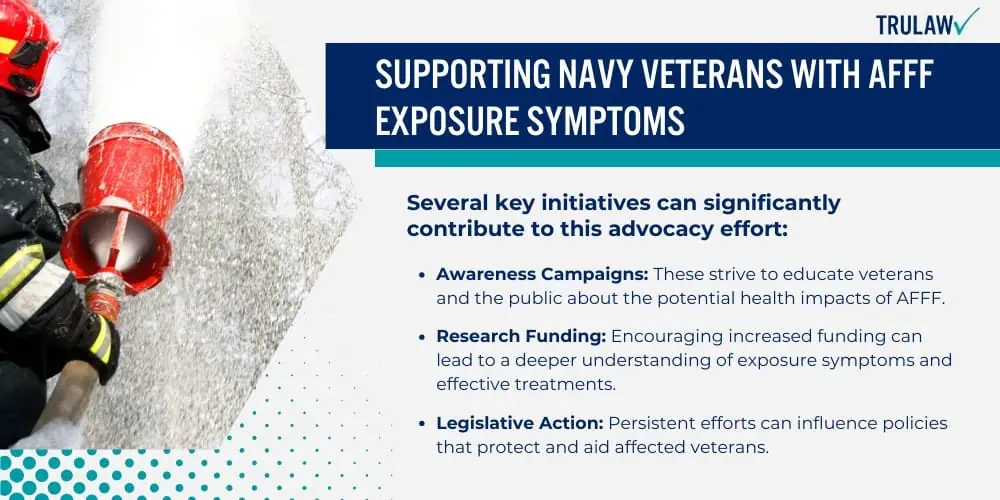
This section offers insight into support mechanisms focusing on awareness, research, and health monitoring.
Advocating for Increased Awareness and Research
Advocacy for greater awareness and investment in research is pivotal to comprehending the ramifications of AFFF exposure among Navy veterans.
Several key initiatives can significantly contribute to this advocacy effort:
- Awareness Campaigns: These strive to educate veterans and the public about the potential health impacts of AFFF.
- Research Funding: Encouraging increased funding can lead to a deeper understanding of exposure symptoms and effective treatments.
- Legislative Action: Persistent efforts can influence policies that protect and aid affected veterans.
- Military and Civilian Partnerships: Collaboration enhances the dissemination of vital information regarding AFFF.
Connecting with Support Groups and Resources
Connecting with support groups and tapping into available resources can provide a support network for Navy veterans affected by AFFF.
Here are some key ways veterans can find the support and information they need:
- Veteran Support Organizations: Groups such as the VA Public Health are crucial for veterans seeking assistance.
- Educational Materials: Access to clear and accurate information helps veterans understand their condition.
- Online Communities: Forums and social media platforms offer spaces for shared experiences and coping strategies.
- Healthcare Assistance Programs: These programs can alleviate the financial burden of ongoing medical care.
Encouraging Proactive Health Monitoring and Early Intervention
Prompt health monitoring and early intervention are essential strategies for mitigating the health impact of AFFF exposure.
The following are recommended proactive measures for veterans potentially exposed to AFFF:
- Regular Health Screenings: Veterans are encouraged to participate in periodic check-ups for early detection of symptoms.
- Biomonitoring Efforts: These measure the presence of AFFF-related chemicals in the body and can signal potential health risks.
- Preventive Measures: Awareness of preventive healthcare can significantly benefit long-term well-being.
- VA Healthcare Programs: The VA offers specific programs to aid veterans with exposure-related health concerns.
Preventing Future AFFF Exposure in the Military
The United States military is reducing AFFF exposure by adopting safer alternatives, improving safety protocols, and bolstering education and training programs.
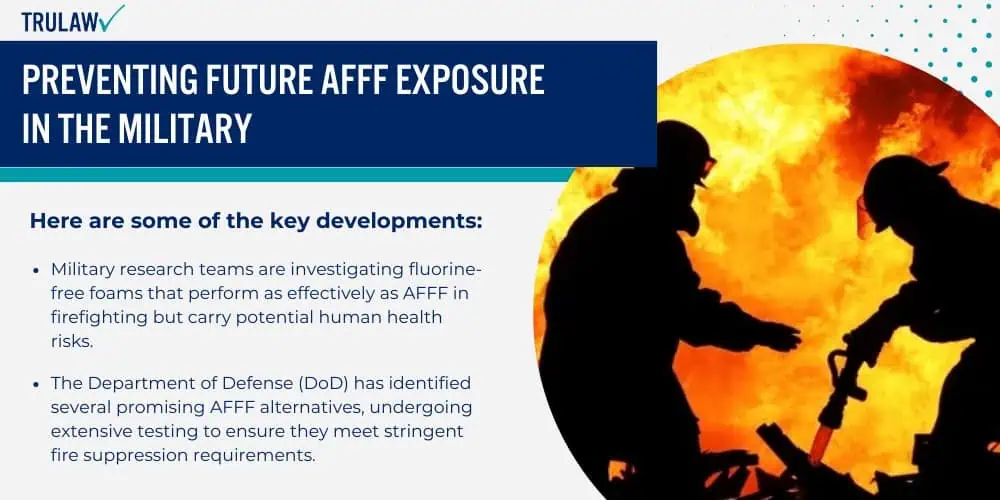
These efforts aim to mitigate the potential health risks associated with AFFF.
Implementing Safer Alternatives to AFFF Chemicals
Efforts to replace AFFF with less hazardous substances are underway.
Here are some of the key developments:
- Military research teams are investigating fluorine-free foams that perform as effectively as AFFF in firefighting but carry potential human health risks.
- The Department of Defense (DoD) has identified several promising AFFF alternatives, undergoing extensive testing to ensure they meet stringent fire suppression requirements.
- Transition plans to phase in these alternatives are being developed, prioritizing effectiveness and safety.
- Continuous investment in R&D aims to stay ahead of emerging safety concerns and adapt to newer, advanced firefighting foams.
Enhancing Safety Protocols and Personal Protective Equipment
New protocols are being established to minimize direct contact with AFFF.
Here are some of the recent measures taken to improve safety:
- Service members who may interact with AFFF are now provided with improved personal protective equipment (PPE), which includes gloves, masks, and suits.
- Strict guidance is provided on the handling, storage, and disposal of AFFF to prevent environmental contamination and human exposure.
- Decontamination procedures for equipment and personnel have been enhanced post-exposure.
- Regular maintenance checks for leaks or spills in AFFF-containing systems help promptly catch and rectify potential risks.
Providing Comprehensive Education and Training on AFFF Risks
Informing military personnel about the risks associated with AFFF is critical.
To ensure this, the following educational initiatives have been implemented:
- Training programs have been updated to include information on the adverse health effects of AFFF exposure.
- There’s a focus on proper usage techniques that minimize unnecessary exposure.
- Environmental impact education highlights the consequences of AFFF release into the surrounding areas.
- Personnel are taught the importance of using alternatives whenever possible, reinforcing a safety and responsibility culture.
AFFF Lawsuit Frequently Asked Questions
-
Exposure to Aqueous Film Forming Foam (AFFF) can lead to various health effects, most notably in the liver, thyroid, and blood.
Certain components in AFFF, such as PFOS and PFOA, have been associated with reproductive and developmental issues.
-
Studies indicate that sustained exposure to substances found in firefighting foams, particularly polyfluoroalkyl substances (PFAS), may be linked with an increased risk of developing certain cancers, including kidney and testicular cancers.
-
After contact with AFFF, individuals should monitor for respiratory issues, skin irritations, and any signs of hormonal imbalances, as these may indicate exposure to harmful chemicals.
Symptoms can also include changes in cholesterol levels and liver enzymes.
-
Veterans exposed to firefighting foams who have developed health complications may be eligible for disability benefits through the VA, as indicated by the recent Honoring our PACT Act of 2022.
-
The types of cancer associated with toxic firefighting foam exposure include kidney, testicular, and bladder cancers.
Moreover, exposure has been potentially connected to prostate, pancreatic, and liver cancers.
-
Individuals affected by AFFF exposure can seek legal redress, often through product liability claims against manufacturers.
Securing compensation for medical expenses, lost wages, and suffering is a legal avenue for those impacted.

Managing Attorney & Owner
With over 25 years of legal experience, Jessica Paluch-Hoerman is an Illinois lawyer, a CPA, and a mother of three. She spent the first decade of her career working as an international tax attorney at Deloitte.
In 2009, Jessie co-founded her own law firm with her husband – which has scaled to over 30 employees since its conception.
In 2016, Jessie founded TruLaw, which allows her to collaborate with attorneys and legal experts across the United States on a daily basis. This hypervaluable network of experts is what enables her to share the most reliable, accurate, and up-to-date legal information with our readers!
Additional AFFF Lawsuit resources on our website:
Here, at TruLaw, we’re committed to helping victims get the justice they deserve.
Alongside our partner law firms, we have successfully collected over $3 Billion in verdicts and settlements on behalf of injured individuals.
Would you like our help?
At TruLaw, we fiercely combat corporations that endanger individuals’ well-being. If you’ve suffered injuries and believe these well-funded entities should be held accountable, we’re here for you.
With TruLaw, you gain access to successful and seasoned lawyers who maximize your chances of success. Our lawyers invest in you—they do not receive a dime until your lawsuit reaches a successful resolution!
AFFF Lawsuit claims are being filed against manufacturers of aqueous film-forming foam (AFFF), commonly used in firefighting.
Claims allege that companies such as 3M, DuPont, and Tyco Fire Products failed to adequately warn users about the potential dangers of AFFF exposure — including increased risks of various cancers and diseases.
Depo Provera Lawsuit claims are being filed by individuals who allege they developed meningioma (a type of brain tumor) after receiving Depo-Provera birth control injections.
A 2024 study found that women using Depo-Provera for at least 1 year are five times more likely to develop meningioma brain tumors compared to those not using the drug.
Suboxone Tooth Decay Lawsuit claims are being filed against Indivior, the manufacturer of Suboxone, a medication used to treat opioid addiction.
Claims allege that Indivior failed to adequately warn users about the potential dangers of severe tooth decay and dental injuries associated with Suboxone’s sublingual film version.
Social Media Harm Lawsuits are being filed against social media companies for allegedly causing mental health issues in children and teens.
Claims allege that companies like Meta, Google, ByteDance, and Snap designed addictive platforms that led to anxiety, depression, and other mental health issues without adequately warning users or parents.
Transvaginal Mesh Lawsuits are being filed against manufacturers of transvaginal mesh products used to treat pelvic organ prolapse (POP) and stress urinary incontinence (SUI).
Claims allege that companies like Ethicon, C.R. Bard, and Boston Scientific failed to adequately warn about potential dangers — including erosion, pain, and infection.
Bair Hugger Warming Blanket Lawsuits involve claims against 3M — alleging their surgical warming blankets caused severe infections and complications (particularly in hip and knee replacement surgeries).
Plaintiffs claim 3M failed to warn about potential risks — despite knowing about increased risk of deep joint infections since 2011.
Baby Formula NEC Lawsuit claims are being filed against manufacturers of cow’s milk-based baby formula products.
Claims allege that companies like Abbott Laboratories (Similac) and Mead Johnson & Company (Enfamil) failed to warn about the increased risk of necrotizing enterocolitis (NEC) in premature infants.
Here, at TruLaw, we’re committed to helping victims get the justice they deserve.
Alongside our partner law firms, we have successfully collected over $3 Billion in verdicts and settlements on behalf of injured individuals.
Would you like our help?
